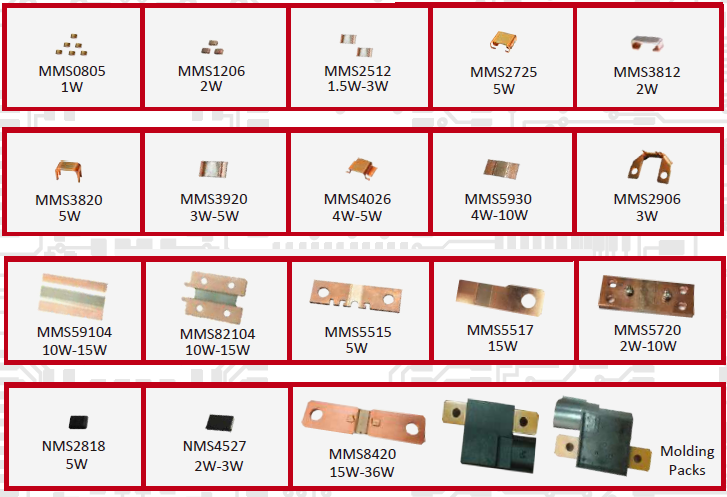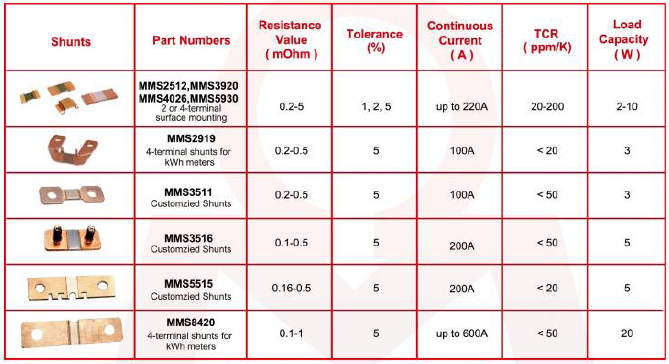Position:Home » Technical Articles
Shunt Resistors' Main Paramaters
Writer:Microhm Page View:Date:2019-05-20
Shunt resistors is primarily used to measure current. However, the meaning of the term shunt in electronics is broader than that. A shunt is an element that is used in a circuit to redirect current around another part. The areas of application vary widely. For some applications, electrical devices other than resistors can be used. A few examples are given to illustrate the diversity of shunts.

Several parameters are important to specify a shunt resistor. Shunt resistors have a maximum current rating. The resistance value is given by the voltage drop at the maximum current rating. For example, a shunt resistor rated with 100A and 50mV has a resistance of 50 / 100 = 0.5 mOhm. The voltage drop at maximum current is typically rated 50, 75 or 100 mV.

Other important parameters include the resistance tolerance, the temperature coefficient of resistance and the power rating. The power rating indicates the amount of electric power that the resistor can dissipate at a given ambient temperature without damaging or changing the resistor parameters. The produced power can be calculated with Joules law. Shunt resistors have usually a derating factor of 66 percent for continuous operation. This is defined for a run time longer than two minutes. High temperatures negatively influence the accuracy of the shunt. From 80 degrees Celsius thermal drift starts. This gets worse with rising temperature, and from 140 degrees the resistor will damage and the resistance value be permanently changed.

Several parameters are important to specify a shunt resistor. Shunt resistors have a maximum current rating. The resistance value is given by the voltage drop at the maximum current rating. For example, a shunt resistor rated with 100A and 50mV has a resistance of 50 / 100 = 0.5 mOhm. The voltage drop at maximum current is typically rated 50, 75 or 100 mV.

Other important parameters include the resistance tolerance, the temperature coefficient of resistance and the power rating. The power rating indicates the amount of electric power that the resistor can dissipate at a given ambient temperature without damaging or changing the resistor parameters. The produced power can be calculated with Joules law. Shunt resistors have usually a derating factor of 66 percent for continuous operation. This is defined for a run time longer than two minutes. High temperatures negatively influence the accuracy of the shunt. From 80 degrees Celsius thermal drift starts. This gets worse with rising temperature, and from 140 degrees the resistor will damage and the resistance value be permanently changed.
Keywords:Shunt resist
Latest News
- Resistor's role in measuring and correcting LED,,,
- Single through-hole resistors' characteristics ,,,
- Why shunt resistors for current sense applicati,,,
- Metal-film resistors with small size, high resi,,,
- 36W High-Current Shunt Resistors MMS8420,,,
- 1W Surface Mount Resistor MPR1206,,,
- An Overview of Microhm Electronics' Resistor Pr,,,
- More anti-sulfur resistors used in harsh envir,,,
- Resistance changes with temperature,,,
- 140W TO247 High Power Heatsinkable Resistor,,,
- MMS5930 is ideal for current sensing in industr,,,
- Shunt resistors selection for engineers' design,,,
- Considerations for choosing precision resistors,,,
- Ceramic Encased Cement Resistors NWH Series for,,,
- Resistors for Passive Balancing in Battery-Pow,,,
Hot Articles
- Microhm will take part in 10th Automotive World,,,
- Thanks for Visiting Microhm's Booth E5-5706 in ,,,
- Resistors in Short Supply: Blame Cars,,,
- New lunch: High Power Precision Shunt Resistor,,,,
- How to Test a Resistor,,,
- Innovative Technology, Future Electric: Electri,,,
- What is Precision Resistors?,,,
- SMD Resistors Sizes and Packages,,,
- The Construction and Features of Metal Film Res,,,
- What is a TO-220 Resisor?,,,
- Hot Selling Products: Precision Shunt Resistors,,,
- How to Calculate the Equivalent Resistance Valu,,,
- What is a Fixed Resistor?,,,
- Resistors in LED Circuits,,,
- Resistors Types and Materials Overview,,,
Resistance applications
- The Measurement Accuracy of Automotive Shunt is,,,
- Miniature future for passive electronic compone,,,
- Heater Blower Motor Resistor in Air Conditioner,,,
- Why Zero-Ohm Resistors?,,,
- The Four Important Functions of Alloy Resistors,,,
- Industrial Roberts Applied to Solar Photovoltai,,,
- Surface Mount Resistor's Size and Package ,,,
- Shunt Resistor MMS8420 for High Current Stable ,,,
- BMS for New Energy Vehicle,,,
- Select the Right Resistor for Harmonic Filterin,,,
- Precision Resistors' Construction and TCR,,,
- The Main Application for High Precision and Low,,,
- Urbanization Development Bringing the Transform,,,
- Difference Between High Precision Resistors and,,,
- Carbon Film Resistors' Features and Application,,,
